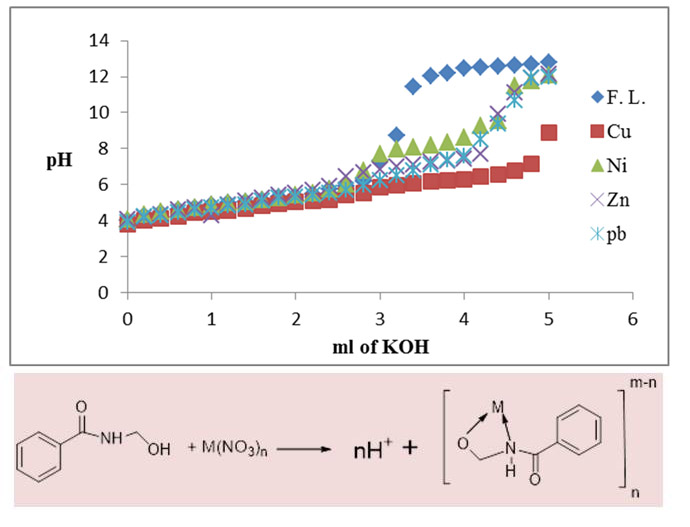References
[1] H. Borsook and J.W. Dubnoff, The biological synthesis of hippuric acid in vitro. Journal of Biological Chemistry, 132 (1940) 307-324.
[2] S. Roobinisha, K. Elango, S. Jothimani and R. Subramanian, Isolation of hippuric acid from buffalo urine and its antioxidant activity. Buffalo Bulletin, 36 (2017) 531-536.
[3] M.C. Capllonch, A. Garcı́a-Raso, A. Terrón, M.C. Apella, E. Espinosa and E. Molins, Interactions of d10 metal ions with hippuric acid and cytosine. X-ray structure of the first cadmium (II)–amino acid derivative–nucleobase ternary compound. Journal of inorganic biochemistry, 85 (2001) 173-178.
[4] P. Sgarabotto, F. Bisceglie, G. Pelosi and L. Abdel-Rahman, Synthesis, X-ray crystal structures and characterization of copper (II)-2, 2′-bipyridyl derivatives of (4-amino)-hippuric acid and of l-proline. Polyhedron, 18 (1999) 2505-2510.
[5] G. Kumar, Synthesis and Characterization of Mixed Ligand Complexes of Nickel (II) with Histidine and Hippuric Acid. Asian Journal of Chemistry, 22 (2010) 676.
[6] L. Antolini, L. Battaglia, A. Bonamartini Corradi, G. Marcotrigiano, L. Menabue, G.C. Pellacani and M. Saladini, Synthesis, spectroscopic and magnetic properties of mixed-ligand complexes of copper (II) with imidazole and nitrogen-protected amino acids. Crystal and molecular structure of bis (hippurate) bis (imidazole) copper (II). Inorganic Chemistry, 21 (1982) 1391-1395.
[7] J. Brown, H. Eichelberger, E. Schaeffer, M. Good and L. Trefonas, Physical parameters and crystal structure of a unique pentacoordinate copper (II) hippurate dimer. Journal of the American Chemical Society, 93 (1971) 6290-6292.
[8] G. Kumar and M. Srivastava, Spectral and magnetochemical studies of nickel (II) and cobalt (II) complexes of hippuric acid. Rev Chim Miner, 16 (1979) 14-8.
[9] M. Saladini, L. Menabue, E. Ferrari and D. Iacopino, Amide group coordination to the Hg 2+ ion. Potentiometric, 1H NMR and structural study on Hg 2+–N-protected amino acid systems. Journal of the Chemical Society, Dalton Transactions, (2001) 1513-1519.
[10] S. Sawhney and A. Konli, Kinetics of the non-isothermal decomposition of some metal hippurates from DTG curves. Thermochimica Acta, 56 (1982) 217-219.
[11] S. Sadeek, M. Refat, S. Teleb and S. El-Megharbel, Synthesis and characterization of V (III), Cr (III) and Fe (III) hippurates. Journal of molecular structure, 737 (2005) 139-145.
[12] M. Refat, S. Teleb, S. Sadeek, H. Khater and S. El-Megharbel, Synthesis and characterization of some hippurato rare earth metal complexes. Journal of the Korean Chemical Society, 49 (2005) 261-268.
[13] H.M. Badawi and A.A. Al-Saadi, Conformational profile and vibrational assignments of hippuric and 4-aminohippuric acids. Journal of Molecular Structure, 990 (2011) 176-182.
[14] R. Tewari and M. Srivastava, Formation and stabilities of some rare earth metal ion chelates of l-asparagine and l-glutamine. Journal of Inorganic and Nuclear Chemistry, 35 (1973) 3044-3045.
[15] D. Kayande, A. Zaid, V. Pradhan and M. Farooqui, Potentiometric study on stability of binary and ternary complexes of nicotinamide in aqueous solution with copper (II) metal ion. Int J Sci Nat, 3 (2012) 438-441
[16] A. Hayat, T.M. Jahangir, M. Yar Khuhawar, M. Alamgir, R. Ali, A. Ali and S.G. Musharraf, Determination of Important Phenolic Compounds in Pakistani Brown Rice Varieties in Controlled, Germinated and Fermented Conditions by High Performance Liquid Chromatography. Prog. Chem. Biochem. Res., 2 (2019) 134-142.
[17] O. Weber, Stability of proton and Cu (II) complexes of some tyrosine and tryptophan derivatives. Journal of Inorganic and Nuclear Chemistry, 36 (1974) 1341-1347.
[18] R. Jalilian and A. Taheri, Synthesis and application of a novel core-shell-shell magnetic ion imprinted polymer as a selective adsorbent of trace amounts of silver ions. e-Polymers, 18 (2018) 123-134.
[19] N.A. Al-Najjar, B.M. Sarhane and Y.A. Majid, STABILITY CONSTANT OF SOME METAL ION OF COMPLEXES (4-AMINO HIPPURIC ACID) IN AQUEOUS SOLUTIONS. Journal of Al-Nahrain University-Science, 11 (2008) 1-8.
[20] A. J, Haana ford, Peter W. G and S. Austinr., Vogel's text book of practical organic chemistry Vol. 5. (1989): Tatchell. 1156.
[21] H. Irving and H. Rossotti, 680. Methods for computing successive stability constants from experimental formation curves. Journal of the Chemical Society (Resumed), (1953) 3397-3405.
[22] H. Irving and R. Williams, Order of stability of metal complexes. Nature, 162 (1948) 746.
How to cite this manuscript:
N. Bader, A. Elmajbry, Z. Al borki, A. Ahmida and A. Geath, Physico-chemical studies of the complexes of Hippuric acid with Cu(II), Ni(II), Zn(II), and Pb(II) ions in ethanol-water mixed solvent system. Progress in Chemical and Biochemical Research, 3(2020) 1-6.
.DOI: 10.33945/SAMI/PCBR.2020.1.1


